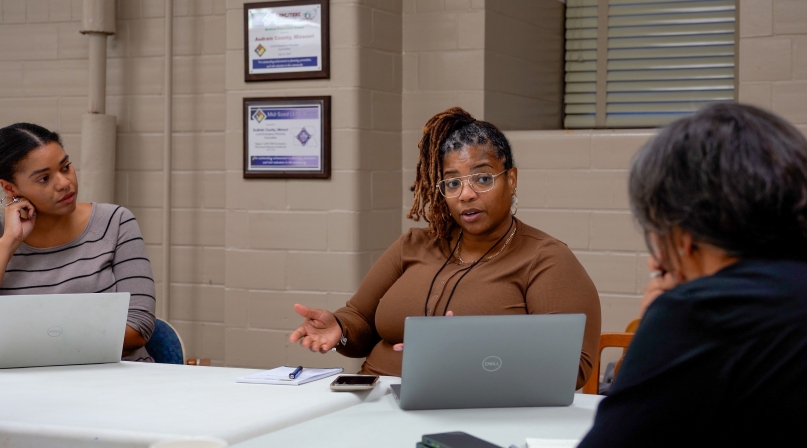Bridging the digital divide in Telfair County, Ga.

Key Takeaways
In rural Georgia, Telfair County is taking meaningful steps toward expanding broadband access as a strategic lever for economic mobility. With a $50,000 “subgrant” through the NACo Rural Leaders for Economic Mobility (RLEM) initiative, the county plans to pilot an innovative Wi-Fi kiosk program to increase digital access and support long-term community development goals.
Filling the information gaps
When first joining the RLEM program, one of Telfair County’s most immediate challenges was insufficient data about broadband infrastructure, available providers and funding opportunities. NACo facilitated connections with RLEM partner organization Rural LISC (Local Initiatives Support Organization), which provided technical assistance and strategic guidance for the county’s broadband efforts through 2026.
With Rural LISC support, the county conducted GIS mapping to identify least-served areas and previously unknown internet service providers (ISPs). These new insights led to direct engagement between county leadership and providers, laying groundwork for future strategic partnerships and infrastructure planning.
“There are some parts of the county that have just never had much access to high-speed internet,” said Telfair County Commissioner Dakkia Bradshaw. “We have an area in the unincorporated part of the county that we hope to attract some industrial and commercial development, but there’s no reliable broadband out there. Having service out there is going to be crucial to growing our economy, and there are some parts of the county that won’t even get service from certain providers.”
Strategic subgrant funding
The goal of Telfair County’s $50,000 subgrant is to launch a pilot project focused on deploying Wi-Fi kiosks in up to two of its five municipalities. These kiosks will be placed in public locations with high foot traffic, such as libraries, city halls and community centers. The intention is to provide free internet access to residents and to collect usage data to inform decisions about further investment in high-need areas.
The pilot is designed to improve access to resources, including telehealth, online education, workforce training and civic services, which are key drivers of economic mobility in rural communities.
“We’re also going to be able to gather data on what kind of information people are using when they use the kiosks,” Bradshaw said. “Are they looking for jobs, or accessing telemedicine?”
Data from the pilot, such as connection speeds, geographic usage and session duration, will inform the county’s broader digital inclusion strategy and underpin future funding and partnership opportunities.
Local collaboration and innovation
As Telfair County advances this work, the partnerships formed during the early stages are proving vital. The county is not only engaging with traditional ISPs but also exploring alternative connectivity solutions, such as mobile virtual network operators, which are wireless communication service providers that do not own the wireless network infrastructure. Partnerships with social enterprise organizations like Human-I-T and PCs for People are helping bridge the digital divide with distribution of low-cost technology to residents who cannot afford market-rate computers and other devices.
This multi-pronged approach reflects a growing recognition that solving rural broadband challenges requires both physical infrastructure and access to digital tools.
“We’re generally a bedroom community, but that means people who work from home need certain levels of service to do their jobs,” Bradshaw said. “Or it’s a matter of being able to access telehealth services from home. If you can’t use video services, you might as well go to the doctor in person. And when some of your residents make $40,000 a year, a $69 internet bill for service that isn’t very good is hard on them.”
What’s next?
During the pilot phase, Telfair County is building the relationships, infrastructure and data systems needed to scale broadband access throughout the county and region. The process has also fostered capacity-building within local government by helping to identify gaps, establish partnerships and strengthen the foundation for future economic initiatives.
Over the coming months, Telfair County will complete its community engagement, site selection and installation of Wi-Fi kiosk. By April 2026, the county plans to report on findings and recommendations to facilitate expanding broadband access across all five municipalities.
A model for rural counties
For rural counties facing similar digital access challenges, Telfair County’s incremental, data-informed approach demonstrates that progress is possible, even with limited resources. With ongoing support from NACo and Rural LISC, Telfair County’s story serves as an example of what’s possible when rural counties have the right mix of funding, technical assistance, partnerships and peer learning to navigate complex challenges.
Related News

Counties and Railroads: Shared Priorities for the Next Surface Transportation Bill
County leaders from across the country have a vital opportunity to ensure their infrastructure priorities are front and center.

House reintroduces bipartisan legislation to level playing field for rural communities
House reintroduced the Rural Partnership and Prosperity Act, bipartisan legislation intended to advance economic development in rural counties and overcome barriers to obtaining federal funding and resources.

Podcast: Eastern Tennessee counties invest in tourism during shutdown
Sevier County, Tenn. refused to let the government shutdown devastate its fall tourism draw—Great Smoky Mountains National Park. County Mayor Larry Waters describes the lengths he and his neighbors went to keep the park open. And NACo Chief Government Affairs Officer Mark Ritacco offers an outlook on what counties can take away from the shutdown and into the future.
County News
Counties tackle ‘backwater’ broadband

